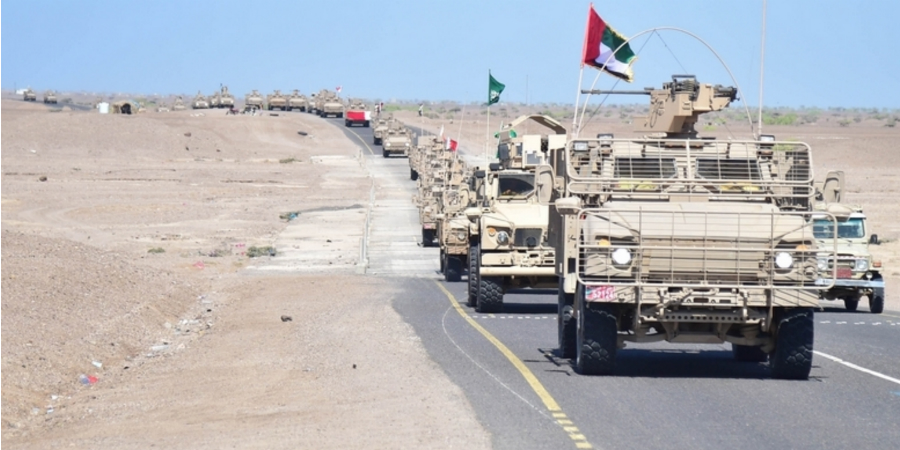Lessons From the UAE War in Yemen
Editor’s Note: Yemen's civil war has dragged on for years, and the destruction and suffering there intensified after the Saudi and UAE intervention in 2015. Although Riyadh's role gets far more attention than Abu Dhabi's, it was UAE forces that often had the biggest impact on the ground. Earlier this year, however, the UAE announced it was suddenly ending its intervention. Michael Knights of the Washington Institute spent considerable time with UAE forces in Yemen, and he assesses the lessons that the UAE is learning, and should learn, from its intervention.

Published by The Lawfare Institute
in Cooperation With

Editor’s Note: Yemen's civil war has dragged on for years, and the destruction and suffering there intensified after the Saudi and UAE intervention in 2015. Although Riyadh's role gets far more attention than Abu Dhabi's, it was UAE forces that often had the biggest impact on the ground. Earlier this year, however, the UAE announced it was suddenly ending its intervention. Michael Knights of the Washington Institute spent considerable time with UAE forces in Yemen, and he assesses the lessons that the UAE is learning, and should learn, from its intervention.
Daniel Byman
***
In 2018, I undertook four visits to “embed” with the United Arab Emirates (UAE) forces in Yemen. I lived with them, ate with them, interviewed them and observed them operating on every battlefield where they were present. As a result, I had mixed feelings when, along with the rest of the world, I received the news on July 8 that the UAE would begin a phased withdrawal of its military forces from Yemen.
On the one hand, the Emirati forces deserve a rest after five years of continuous operations in Yemen. The UAE is not a large country and maintains a deployable ground force of fewer than 20,000 troops. Around 3,500 UAE troops were deployed in Yemen, with nearly 3,000 additional UAE airmen, sailors and soldiers operating in direct support offshore and in neighboring regions. About a sixth of the country’s entire fighting force was at war at any given moment, and the commanders I worked with had been deployed almost continuously since the war’s start in 2015. From their perspective, the Emiratis believe—with good reason—that they stopped the Houthi rebels from taking over most of Yemen and, simultaneously, prevented al-Qaeda from setting up its largest territorial caliphate after it made inroads in the port of Mukalla in 2015.
The withdrawal, though, began while Yemen is still exceedingly fragile. The cement has not set on the gains achieved by the UAE in removing Houthi rebels and al-Qaeda presence from large swaths of Yemen and returning a semblance of functioning governance. This shows clearly in the current interfactional fighting in Yemen’s second largest city of Aden. Since Aug. 7, local militias championing southern Yemeni autonomy have been engaged in heavy fighting with military units loyal to the internationally recognized central government of President Abd-Rabbu Mansour Hadi. Previously, a UAE battlegroup had mostly kept a lid on major fighting among armed groups allied against the Houthis, but now that restraining factor is absent. Highly accurate Houthi missile and drone attacks have also intensified since the withdrawal announcement, stoking fear of a Houthi comeback. Out in the countryside, local security forces have begun battling each other, sometimes using tank cannon fire, to settle their differences as the UAE has stepped back from crisis management.
Speaking to deployed and returned UAE officers, and also Yemeni and Saudi troops and officials, I formed a number of impressions about the lessons that the Emirates and other interested parties will take away from the UAE intervention in Yemen, which may now be transitioning to a less resource-intensive and less prominent phase.
The first lesson is that a capable and compact regional military, such as the UAE armed forces, can launch—and win—complex combat operations on their own. When UAE special forces began to roll back the Houthi rebel advance in Aden in April 2015, they were almost entirely alone. Saudi support was limited to some airstrikes, while the United States discouraged a unilateral UAE operation to save southern Yemen from the Houthis. Prior to the Yemen war, the UAE had worked alongside NATO forces in Kosovo, Afghanistan and Libya, plus a host of other operations, but they had never planned and executed an entire operation on their own that used almost entirely their own airpower, sealift and ground forces. Today, the UAE has planned dozens of major combat operations in Yemen, including urban warfare, amphibious landings, armored pursuit operations, precision strike operations with NATO-standard consideration of humanitarian law and noncombatant immunity, stabilization and reconstruction operations, and unconventional warfare in support of local proxies. The UAE is the best Arab military because it invested in quality professional military education, stayed a compact size, and energetically sought out opportunities to partner in real-world operations with NATO-standard forces.
The second lesson is that U.S. counterterrorism operations are greatly aided by a capable regional partner who can act as a coordinating link between extraregional and local forces. Prior to the UAE deployment against al-Qaeda in the Arabian Peninsula (AQAP) in 2015, the United States undertook mainly unilateral drone strikes, while Yemeni military unilateral actions against AQAP were ineffective and timid. The UAE added a third transformative ingredient to the formula: a middle layer in what are now called “trilateral operations,” with the UAE providing an Arabic-speaking, culturally attuned ground presence to undertake hands-on management of Yemeni counterterrorism forces and to exchange information and support with unique U.S. intelligence and strike capabilities.
As in the war against the Houthis, the UAE operations against AQAP saw the Emirates excel at quickly building local auxiliary forces that were “good enough” and delivering civil-military aid in a timely and adroit manner to local communities. The result has been to show locals that al-Qaeda is not ascendant, capping the terrorist group’s ability to intimidate and recruit. Though some reporting has characterized the Emiratis as “paying off” or even co-opting AQAP fighters, it would be more accurate to say the UAE defeated AQAP on the battlefield and splintered its support base by giving reconcilable tribal auxiliaries an alternative to al-Qaeda. The lesson for NATO militaries may be the value of engaging Islamic world militaries as a partner when operating in the region.
A third lesson is that foreign patrons must put in special effort and risk harming key relationships to prompt local auxiliary forces to meet international expectations on human rights and noncombatant immunity—and this might not be considered worth jeopardizing a strategic partnership. This was particularly evident in Aden, where the battle to liberate the city unleashed militia rule on a previously urbane, if gritty, city. The most powerful armed actors, who had worked with the UAE from the outset to liberate Aden and who were vital to maintaining broad stability, were at the same time violently settling scores and illegally detaining and torturing local rivals. The UAE did not jeopardize its partnership with powerful local actors to prevent such abuses, and this has caused the UAE unforeseen reputational damage. A close relationship with local proxies can come at a cost, and balancing ethics and practicalities is exceedingly challenging.
A fourth lesson relates to the broader Gulf coalition, particularly to Saudi Arabia as a partner. At Saudi Arabia’s behest, the UAE controlled and supported most of the ground offensives inside Yemen against the Houthis and AQAP, but this did not earn the UAE an equal place at the head of the coalition due to the geopolitical power imbalance between Riyadh and Abu Dhabi. At numerous points, the UAE might have done a better job of overall war planning, air campaign targeting and the propaganda battle to shape international opinion, but the Saudis were always in charge of such top-level issues. The war appeared less and less winnable as a result, no-matter how effectively the UAE operated on key battlefields.
In the months after the October 2018 death of Saudi-U.S. journalist Jamal Khashoggi, UAE officials realized that no amount of damage control could ever change the international view of Saudi Arabia or its war in Yemen. The coalition framework arguably provided little to the UAE but cost it a lot. A more palatable formula for the UAE may be unilateral operations or those with a junior partner that employs a lower profile and some international support, perhaps like those the UAE has conducted alongside Egypt, with French support, in Libya.
The UAE concluded, as one senior officer confided, that in Yemen they needed to “fix it or leave.” In the face of blanket international hostility, there was no completing the mission of liberating all the territories the Houthis seized in 2015, most importantly the vital Red Sea ports of Hodeidah and Saleef. The UAE is proud of its military campaign in Yemen, and I can see why: Somewhat like the Korean War, an aggressive enemy tried to wipe an allied government out of existence and occupy the whole country, but they were stopped and held at a halfway point by an international coalition in which the UAE was the principle fighting force. UAE pride about this achievement has made them unwilling to admit that they are now, in fact, withdrawing. As I learned in Iraq in 2009-2011, once you tell the locals that you are leaving, you are effectively already gone. No one listens to you anymore, because you are not staying.
This is the final lesson the UAE will learn in Yemen: Intervening powers are remembered as much for how and when they leave, and what they leave behind, as for what they did while they were present. If the UAE can demonstrate a deft and firm hand in guiding events with a lighter footprint, there may be less to fear. But if, as seems likely, the UAE’s departure has left a major vacuum, this year may witness a complete collapse of the authority of the U.N.-backed government of President Hadi in southern Yemen, as foreshadowed by the major anti-Hadi uprisings in Aden since Aug. 7. In governorates like Shabwah and Hadramaut, local forces will likely complete the slow-burning ejection of Hadi military from key oilfields. The U.N. peace process and U.N. resolutions underpinning the Saudi-led military support to Hadi may crumble. The military balance will shift back toward the Houthis, allowing them to hold Saudi Arabia in a deadlocked struggle in the north, while gradually reexpanding their influence in central Yemen. Fairly or unfairly, the acceleration of many of these developments will be traced back to the early July 2019 announcement of the UAE’s military withdrawal.





